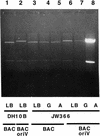Conditionally amplifiable BACs: switching from single-copy to high-copy vectors and genomic clones
- PMID: 12213781
- PMCID: PMC186656
- DOI: 10.1101/gr.130502
Conditionally amplifiable BACs: switching from single-copy to high-copy vectors and genomic clones
Abstract
The widely used, very-low-copy BAC (bacterial artificial chromosome) vectors are the mainstay of present genomic research. The principal advantage of BACs is the high stability of inserted clones, but an important disadvantage is the low yield of DNA, both for vectors alone and when carrying genomic inserts. We describe here a novel class of single-copy/high-copy (SC/HC) pBAC/oriV vectors that retain all the advantages of low-copy BAC vectors, but are endowed with a conditional and tightly controlled oriV/TrfA amplification system that allows: (1) a yield of ~100 copies of the vector per host cell when conditionally induced with L-arabinose, and (2) analogous DNA amplification (only upon induction and with copy number depending on the insert size) of pBAC/oriV clones carrying >100-kb inserts. Amplifiable clones and libraries facilitate high-throughput DNA sequencing and other applications requiring HC plasmid DNA. To turn on DNA amplification, which is driven by the oriV origin of replication, we used copy-up mutations in the gene trfA whose expression was very tightly controlled by the araC-P(araBAD) promoter/regulator system. This system is inducible by L-arabinose, and could be further regulated by glucose and fucose. Amplification of DNA upon induction with L-arabinose and its modulation by glucose are robust and reliable. Furthermore, we discovered that addition of 0.2% D-glucose to the growth medium helped toward the objective of obtaining a real SC state for all BAC systems, thus enhancing the stability of their maintenance, which became equivalent to cloning into the host chromosome
Figures









References
-
- Asakawa S, Abe I, Kudoh Y, Kishi N, Wang Y, Kubota R, Kudoh J, Kawasaki K, Minoshima S, Shimizu N. Human BAC library: Construction and rapid screening. Gene. 1997;191:69–79. - PubMed
-
- Boysen C, Simon MI, Hood L. Analysis of the 1.1-Mb human α/δ T-cell receptor locus with bacterial artificial chromosome clones. Genome Res. 1997;7:330–338. - PubMed
-
- Cai L, Taylor JF, Wing RA, Gallagher DS, Woo SS, Davis SK. Construction and characterization of a bovine bacterial artificial chromosome library. Genomics. 1995;29:413–425. - PubMed
-
- Diaz-Perez SV, Crouch VW, Orbach MJ. Construction and characterization of Magnaporthe grisea bacterial artificial chromosome library. Fungal Genet Biol. 1996;20:280–288. - PubMed
MeSH terms
Substances
LinkOut - more resources
Full Text Sources
Other Literature Sources
